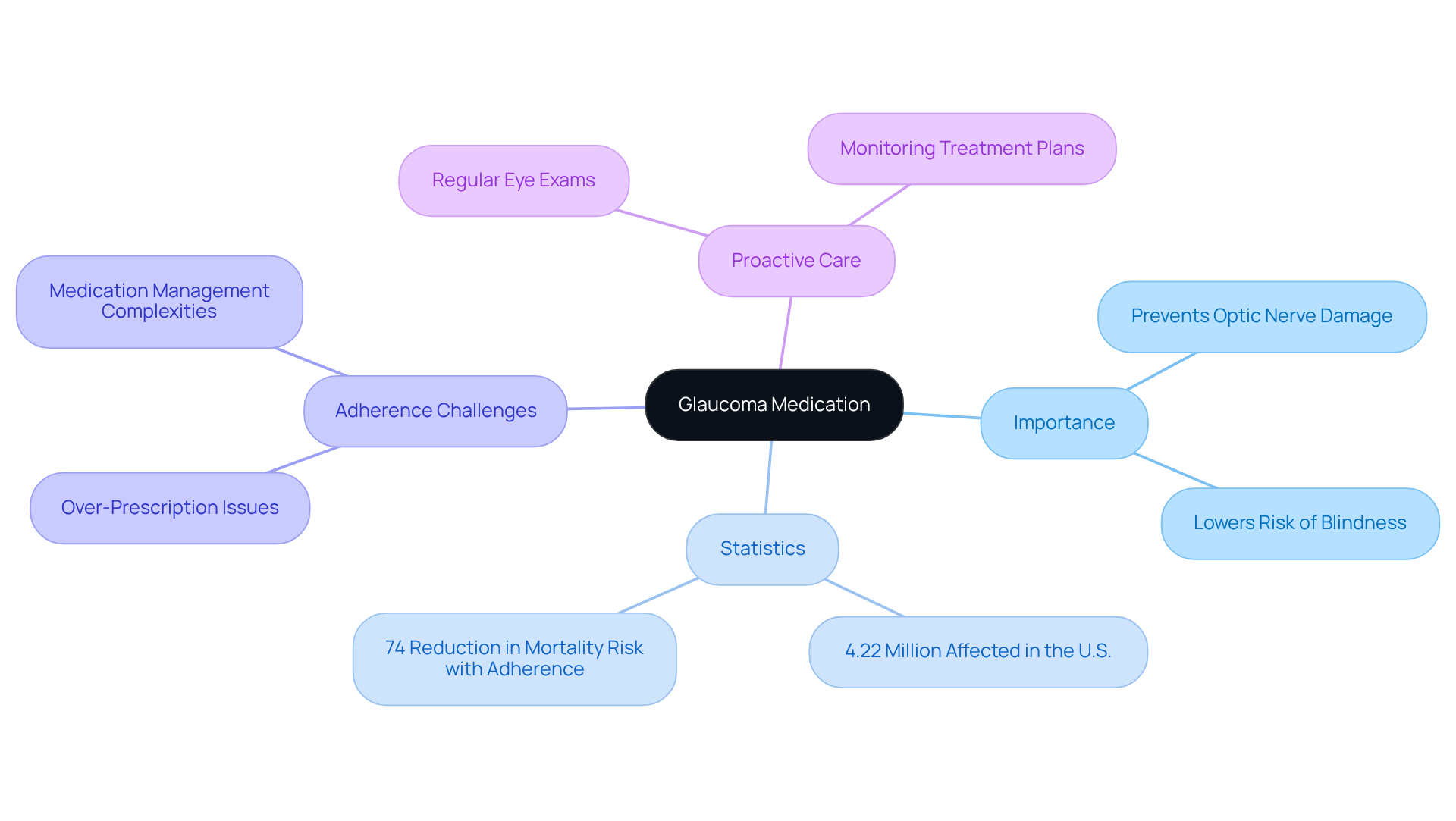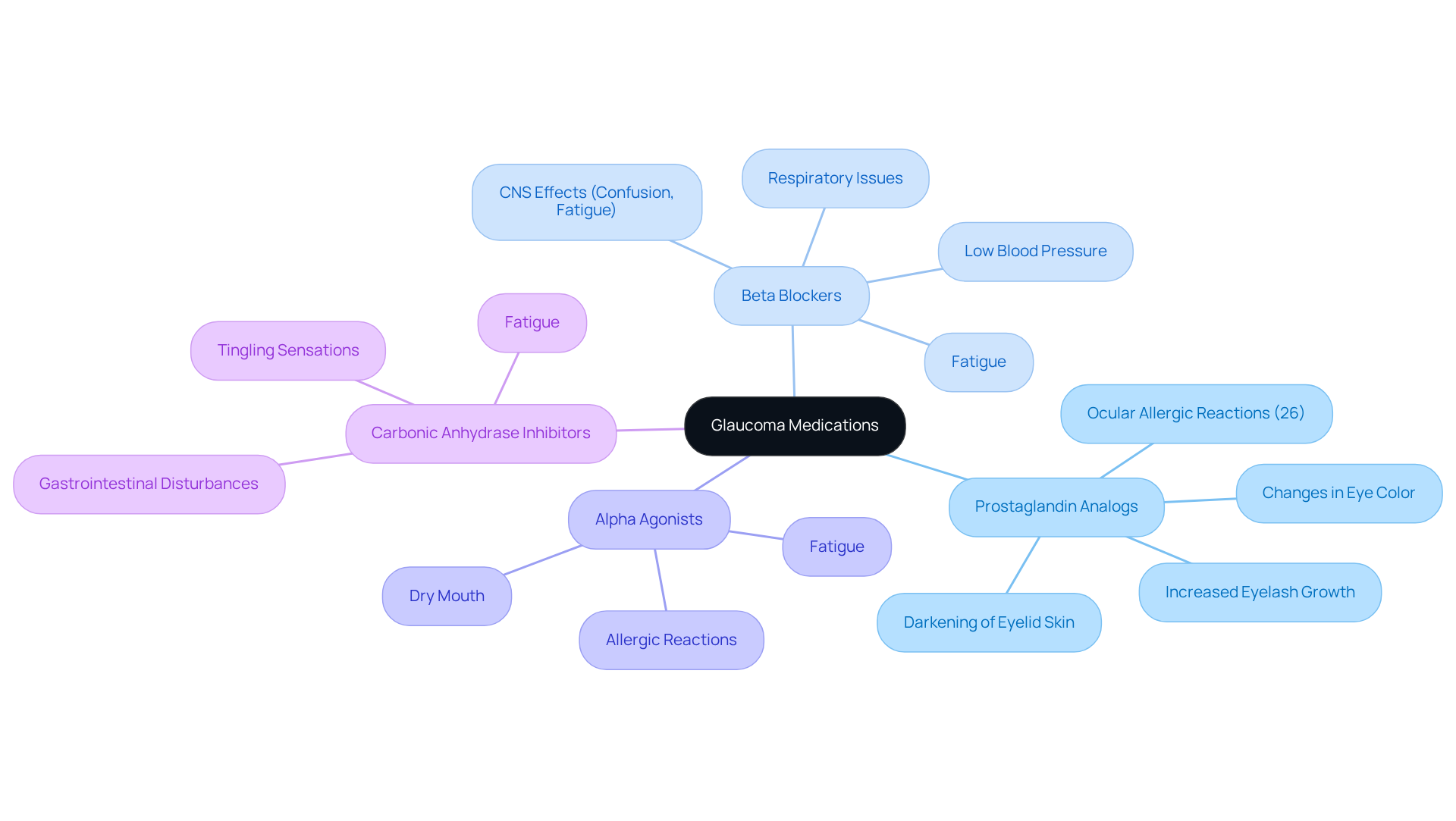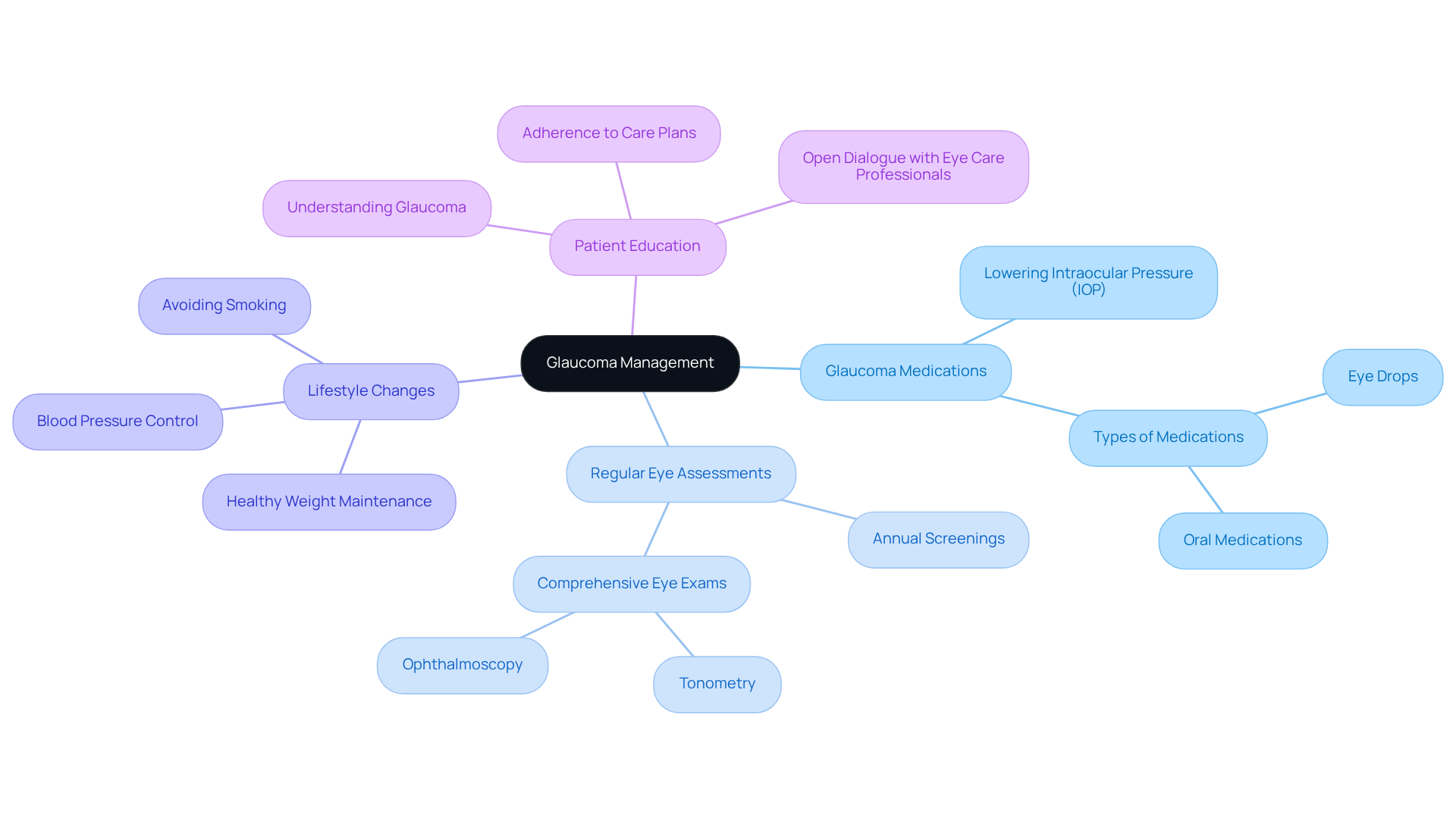Posted by: Northwest Eye in General on July 4, 2025
Overview
This article highlights the crucial role of glaucoma medication in lowering intraocular pressure (IOP), which is vital for preventing optic nerve damage and vision loss. We understand that managing glaucoma can feel overwhelming, but effective treatment goes beyond just taking medication. It also involves:
- Regular monitoring
- Patient education
- Lifestyle changes
These elements are essential as they significantly enhance treatment outcomes and contribute to your overall eye health. Remember, we are here to help you through this process.
Introduction
Understanding glaucoma medication is crucial for the millions affected by this silent yet devastating condition. We recognize that navigating this complex landscape can be overwhelming. These treatments, primarily eye drops and oral medications, play a vital role in lowering intraocular pressure and preventing irreversible vision loss. However, the complexities surrounding medication types, potential side effects, and adherence challenges can leave individuals feeling anxious and uncertain.
It’s common to feel this way, but it’s important to remember that you are not alone in this journey. How can you navigate this intricate landscape to ensure optimal eye health and preserve your vision? We are here to help you through this process.
Define Glaucoma Medication and Its Importance
Glaucoma medication primarily involves prescribed eye drops and oral medications designed to lower intraocular pressure (IOP) for those diagnosed with this condition. The importance of these treatments cannot be overstated; they are crucial in preventing optic nerve damage and subsequent vision loss. We understand that approximately 4.22 million people in the U.S. are affected by glaucoma, which underscores the urgent need for effective treatment and adherence to prescribed regimens.
It’s common to feel overwhelmed, as glaucoma often presents no symptoms in its early stages. This makes regular monitoring and sticking to your treatment plan essential for preserving your sight. By effectively managing IOP through glaucoma medication, these treatments significantly lower the risk of blindness, a major concern for individuals facing this condition. Research indicates that adhering to therapy for eye disease can lead to a remarkable 74% reduction in the risk of mortality, based on a study involving 21,506 participants.
Moreover, we recognize the challenges posed by the over-prescription of eye drops for individuals with eye conditions, illustrating the complexities of medication management and compliance. Creative medication administration techniques and ongoing research into therapies for eye conditions are continually improving patient outcomes. It’s vital for you to actively engage in your treatment strategies. As Lisa M. Young emphasizes, regular eye exams are essential not just for your eye health but also for identifying systemic health issues. This reinforces the importance of proactive care in managing glaucoma.

Explore Types of Glaucoma Medications and Their Functions
Glaucoma medication can be classified into several categories, each with unique mechanisms of action. We understand that navigating these options can feel overwhelming, so let’s break them down together. The most common types include:
-
Prostaglandin Analogs: Medications like latanoprost and bimatoprost increase the outflow of aqueous humor, effectively lowering intraocular pressure (IOP). Typically administered once daily, they are known for their effectiveness and minimal side effects. Notably, bimatoprost has a relative risk (RR) of 1.59 for success, making it a strong choice for many individuals. Clinical studies indicate that bimatoprost can lead to a mean IOP reduction of approximately 1.98 mm Hg after just one month of treatment.
-
Beta Blockers: Medications such as timolol reduce the production of fluid in the eye. They are often prescribed for patients who may not tolerate prostaglandin analogs, providing an alternative that works for you.
-
Alpha Agonists: Drugs like brimonidine decrease fluid production while increasing drainage, offering a dual mechanism of action to help manage your condition.
-
Carbonic Anhydrase Inhibitors: Available in both oral and topical forms, these substances also work to decrease fluid production in the eye.
-
Rho Kinase Inhibitors: This newer category enhances fluid drainage through the trabecular meshwork, representing an exciting advancement in treatment options.
Each type of medication serves a specific purpose in managing glaucoma, and often, a combination of these medications is used to achieve optimal control of IOP. It’s important to consider the economic impact of these therapies; for instance, bimatoprost has been shown to offer greater value and is more affordable compared to other options. While bimatoprost is effective, it’s associated with a higher incidence of conjunctival hyperemia compared to latanoprost, which has the most favorable tolerability profile among the prostaglandin analogs reviewed.
We are here to help you understand these elements as you explore your care options. Remember, you are not alone in this journey, and we are committed to supporting you every step of the way.

Identify Risks and Side Effects of Glaucoma Medications
Glaucoma medication is essential for managing the condition, but we understand that it can come with side effects that may affect your ability to adhere to the prescribed regimen. Recognizing these side effects is vital for effective treatment management. Here are some common side effects you might encounter:
- Prostaglandin Analogs: These medications may lead to changes in eye color, increased eyelash growth, and darkening of the eyelid skin. It’s reported that up to 26% of individuals may experience ocular allergic reactions, highlighting the importance of careful monitoring.
- Beta Blockers: While they effectively lower intraocular pressure, beta blockers can cause systemic effects like fatigue, low blood pressure, and respiratory issues, especially in those who are more susceptible. It’s also common for older individuals to experience central nervous system effects, including confusion and fatigue.
- Alpha Agonists: These may result in dry mouth, fatigue, and allergic reactions, with some individuals facing significant side effects that could hinder their adherence to treatment.
- Carbonic Anhydrase Inhibitors: Patients might report tingling sensations, fatigue, and gastrointestinal disturbances, which can lead to stopping therapy altogether.
Healthcare professionals emphasize the importance of educating you about these potential side effects. We encourage you to communicate any adverse reactions to your healthcare provider promptly. This proactive approach is crucial for maintaining adherence to care plans and ensuring effective management of eye pressure conditions with glaucoma medication.
It’s common to feel overwhelmed, and many individuals face challenges with adherence due to these side effects. Real-world experiences show that less than half of individuals comply with their recommended eye pressure treatment beyond one year, and two-thirds report side effects regardless of treatment duration. With approximately 57.5 million individuals affected by this eye condition globally, understanding and addressing these side effects is essential for improving patient outcomes. Remember, we are here to help you through this process.

Understand the Role of Glaucoma Medications in Eye Health Management
Glaucoma medication is a cornerstone of eye health management for individuals diagnosed with this condition. Their primary role is to lower intraocular pressure (IOP), which is crucial in preventing optic nerve damage and preserving vision. However, we understand that the effective management of glaucoma requires more than just glaucoma medication. Regular eye assessments, lifestyle changes, and client education are equally important elements of a thorough care strategy. The National Eye Institute recommends annual screenings for individuals with risk factors, emphasizing the need for proactive care.
Patient education is vital in this holistic approach. Involving individuals in their care strategies promotes compliance with recommended routines and supports open dialogue with eye care professionals. Dr. Conlon stresses, “Prevention is essential to managing the condition, because so far, there is no method for restoring vision lost to the disease.” Research has indicated that knowledgeable individuals are more inclined to adhere to their care plans, resulting in better outcomes. For instance, individuals who understand the significance of regular follow-ups and lifestyle modifications—such as maintaining a healthy weight and controlling blood pressure—can significantly reduce their risk of vision loss.
Statistics indicate that effective control of IOP can maintain optic nerve well-being, with success rates for eye surgeries varying from 44% to 97.1% at different time intervals. This emphasizes the significance of a thorough care strategy that incorporates glaucoma medication, regular eye exams, and education for individuals. By empowering patients to take an active role in their eye health, we can enhance the effectiveness of glaucoma treatments and improve overall outcomes.

Conclusion
Glaucoma medication plays a vital role in preserving vision and preventing optic nerve damage for millions affected by this condition. We understand that managing this condition can be overwhelming, but these treatments are designed to effectively lower intraocular pressure (IOP), safeguarding against blindness and enhancing overall eye health. It cannot be emphasized enough how important it is to adhere to prescribed regimens; consistent management is crucial for long-term success in combating glaucoma.
Throughout this article, we’ve shared key insights regarding the various types of glaucoma medications, their mechanisms, and the importance of patient education. From prostaglandin analogs to beta blockers and newer options like rho kinase inhibitors, each medication serves a specific function in managing IOP. It’s common to have questions about potential side effects, and maintaining open communication with your healthcare provider is essential for effective treatment strategies.
Ultimately, the significance of glaucoma medication extends beyond just controlling IOP; it encompasses a holistic approach to eye health management. By prioritizing:
- Regular eye exams
- Patient education
- Lifestyle modifications
you can empower yourself to take charge of your eye health. Engaging actively in treatment plans not only improves adherence but also enhances the overall effectiveness of glaucoma therapies. Remember, proactive care is key to preserving your vision, and we are here to help you through this process.
Frequently Asked Questions
What is glaucoma medication?
Glaucoma medication primarily includes prescribed eye drops and oral medications aimed at lowering intraocular pressure (IOP) for individuals diagnosed with glaucoma.
Why is glaucoma medication important?
Glaucoma medication is crucial for preventing optic nerve damage and subsequent vision loss, as it helps manage IOP effectively and reduces the risk of blindness.
How many people are affected by glaucoma in the U.S.?
Approximately 4.22 million people in the U.S. are affected by glaucoma, highlighting the urgent need for effective treatment.
What are the challenges faced by individuals with glaucoma regarding medication?
Individuals with glaucoma may feel overwhelmed due to the lack of early symptoms, making it essential to adhere to treatment plans. Additionally, there are challenges related to the over-prescription of eye drops, complicating medication management and compliance.
How does adherence to glaucoma therapy impact health outcomes?
Adhering to therapy for eye disease can lead to a significant 74% reduction in the risk of mortality, according to a study involving 21,506 participants.
What role do regular eye exams play in managing glaucoma?
Regular eye exams are essential for maintaining eye health and for identifying systemic health issues, which reinforces the importance of proactive care in managing glaucoma.
What are some strategies to improve medication adherence for glaucoma?
Creative medication administration techniques and ongoing research into therapies for eye conditions are being developed to improve patient outcomes and medication adherence.






